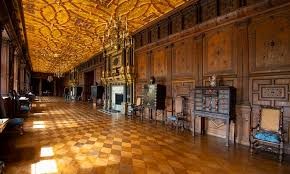Iestyn Davies (countertenor) and Elizabeth Kenny (lute) – Dowland
Richard Gowers (organ) – Handel, Tomkins, Byrd and Tallis
Friday 18 September 2020
Founded by the British cellist Guy Johnson nine years ago, the Hatfield House Chamber Music Festival was one of the relatively few events in Britain to have survived this most catastrophic of years for music making, albeit by adapting itself to the prevailing conditions. Four concerts were filmed and presented before members of the owner Lord Salisbury’s family for relay on YouTube on Friday evenings during September. They were given in several of Hatfield House’s historic and spectacular rooms, the one reviewed here taking place in the magnificent Long Gallery (pictured above) and the Armoury, the home of a historic organ built in 1609.
I have to confess to being no great enthusiast for filmed concerts (or opera for that matter), but the close links between the Cecils (the family name of Lord Salisbury) and John Dowland made the gorgeous setting unusually appropriate and fascinating. It was to the courtier Sir Robert Cecil (from 1605 the 1st Earl of Salisbury) that Dowland wrote a famous letter, a mea culpa in which he tried to excuse himself from having become involved with Roman Catholic plotters in Florence on his aborted trip to Rome. Today the letter is housed in the archives of Hatfield House, allowing Iestyn Davies to take a break from the concert (one advantage of filming) to examine it, a touching moment.
In a trailer both Davies and Elizabeth Kenny spoke of how they had found that the historic associations added a dimension to their performances, feeling that the music resounded sympathetically from their surroundings. Certainly, the acoustic of the Long Gallery was lively, giving both voice and lute ample, rounded sonority. The concert included five of Dowland’s best-known songs and a pair of galliards, those dedicated to the King of Denmark and Lady Rich, for solo lute. Given the well-established qualities of both performers, the performances were never likely to be less than highly satisfying, expectations more than fulfilled. The sweetness and beauty of Davies’ countertenor is never in doubt and here he searched beneath the surface of the texts in a way that to my mind he does not always achieve. Reservations largely concerned the slow tempos at which he took the darkest numbers, including ‘Flow my tears’ and ‘In darkness let me dwell’, which for me resulted in both taking on a measure of 21st-century sentimentality that missed on the ambiguous aspects of Dowland’s attachment to the doleful. But the beautiful messa di voce which the concluding line of each verse of ‘Flow my tears’ ended was something to treasure. Otherwise, it might have been good to have had more varied embellishment in strophic songs, particularly one with as many verses as ‘Come again sweet love’, though Davies caught its light-hearted mood to perfection.
The second part of the concert moved to the Armoury for a short recital given by Richard Gowers on the 1609 organ supplied by John Haan, a Dutchman. One of the few organs from the period to survive, it also retains the beautiful decorations by Rowland Bucket, the artist responsible for many of the interior decorations of Hatfield House. The most substantial piece Gowers played was the second of Handel’s Six Fugues, while he also included the same composer’s mimetic voluntary known as ‘Flight of Angels’, Thomas Tomkins’ odd Voluntary in D and brief works by Byrd and Tallis. The organ has an extraordinarily translucent sound, yet also an agreeable mellowness. The playing was fluent, if not without the odd mishap.
Brian Robins
